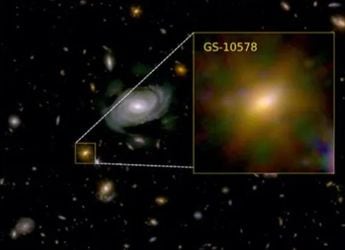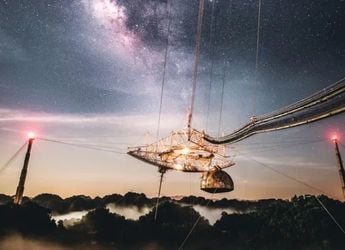- Home
- Science
- Science News
- Stephen Hawking, Physicist Who Came to Symbolise the Power of the Human Mind, Dies at 76
Stephen Hawking, Physicist Who Came to Symbolise the Power of the Human Mind, Dies at 76
Stephen Hawking, the British theoretical physicist who overcame a devastating neurological disease to probe the greatest mysteries of the cosmos and become a globally celebrated symbol of the power of the human mind, has died, a family spokesman told the Associated Press. He was 76.
Unable to move a muscle, speechless but for a computer-synthesised voice, Dr. Hawking had suffered since the age of 21 from a degenerative motor neuron disease similar to amyotrophic lateral sclerosis, or Lou Gehrig's disease.
Initially given two years to live, a diagnosis that threw him into a profound depression, he found the strength to complete his doctorate and rise to the position of Lucasian professor of mathematics at the University of Cambridge, the same post held by Isaac Newton 300 years earlier.
Hawking eventually became one of the planet's most renowned science popularizers, and he embraced the attention, travelling the world, meeting with presidents, visiting Antarctica and Easter Island, and flying on special "zero-gravity" jet whose parabolic flight let Hawking float through the cabin as if he were in outer space.
"My goal is simple," he once said. "It is complete understanding of the universe, why it is as it is and why it exists at all." He spent much of his career searching for a way to reconcile Einstein's theory of relativity with quantum physics and produce a "Theory of Everything."
He wrote an international best seller, "A Brief History of Time (1988)", which delved into the origin and ultimate fate of the universe. He deliberately set out to write a mass-market primer on an often incomprehensible subject.
Although the book was sometimes derided as being dense, and had a reputation for being owned more than read, it sold millions of copies, was translated into more than 20 languages, and inspired a mini-empire of similar books from Hawking, including "The Universe in a Nutshell" and "A Briefer History of Time."
With his daughter, Lucy, he wrote a series of children's books about a young intergalactic traveller named George. His blunt 2013 memoir, "My Brief History," explored his development in science as well as his turbulent marriages. In addition, Hawking was the subject of a 1991 documentary, "A Brief History of Time," directed by Errol Morris, and countless newspaper and magazine articles.
With the aid of a voice synthesizer, controlled by his fingers on a keyboard, he gave speeches around the world, from Chile to China. He played himself on such TV programs as Star Trek: The Next Generation and The Simpsons, the latter featuring Hawking telling the show's lazy animated patriarch, "Your theory of a doughnut-shaped universe is interesting, Homer. I may have to steal it."
He insisted that his reputation as the second coming of Albert Einstein had gotten out of control through "media hype."
"I fit the part of a disabled genius," he told the Los Angeles Times in 1990. "At least, I'm disabled - even though I'm not a genius like Einstein. ... The public wants heroes. They made Einstein a hero, and now they're making me a hero, though with much less justification."
His scientific achievements included breakthroughs in understanding the extreme conditions of black holes, objects so dense that not even light can escape their gravity.
His most famous theoretical breakthrough was to find an exception to this seemingly unforgiving law of physics: black holes are not really black, he realised, but rather can emanate thermal radiation from subatomic processes at their boundary, and can potentially evaporate. Scientists refer to such theoretical emanations as "Hawking radiation."
This revelation impressed other scientists with the way it took Einstein's general theory of relativity, which is essential for understanding the gravity of black holes, and connected it to newer theories of quantum mechanics, which cover subatomic processes.
Plus, he threw in a dash of old-fashioned thermodynamics - achieving a kind of physics trifecta.
"Black holes ain't as black as they are painted," Hawking once said in a lecture, characteristically describing complicated physics in ordinary language. "They are not the eternal prisons they were once thought. Things can get out of a black hole, both to the outside, and possibly, to another universe. So, if you feel you are in a black hole, don't give up. There's a way out."
He also hypothesised that miniature black holes, remnants of the big bang, may be strewn through space, though he noted that so far they haven't be discovered. "This is a pity, because if they had, I would have got a Nobel prize," he joked.
Stephen William Hawking was born in Oxford, England, on January 8, 1942 - the 300th anniversary of Galileo's death, he liked to point out. His father was a physician and specialist in tropical diseases; his mother was active in the Liberal Party.
Both parents were Oxford-educated, and Stephen - the eldest of four siblings - grew up surrounded by books. But he did not show particular academic promise, despite an obvious streak of brilliance that caused his friends to nickname him "Einstein."
"I always wanted to know how everything worked," he told Omni magazine. "I would take things apart to see how they worked, but they didn't often go back together."
He was a bit lazy, and a bon vivant, as he later would admit. After being admitted to the University of Oxford, he skimped on his studies and enjoyed carousing with fellow members of the Oxford Boat Club, for which he was a tactically savvy coxswain. He graduated in 1962 and did just well enough on his final exam to earn admission to the University of Cambridge to pursue a doctorate.
"Physics was always the most boring subject at school because it was so easy and obvious. Chemistry was much more fun because unexpected things, such as explosions, kept happening," Hawking wrote in his memoir. "But physics and astronomy offered the hope of understanding where we came from and why we are here. I wanted to fathom the depths of the Universe."
Then came what he later referred to as "that terrible thing." He'd noticed at Oxford that he'd become increasingly clumsy and would sometimes stumble and fall for no obvious reason. Tests revealed motor neuron disease; he could not expect to live more than a couple of years.
After a period of despondency in which he holed up in his room and listened to Wagner, he attended a New Year's Eve party at which he met a young student named Jane Wilde. Their courtship spurred his will to live. They married in 1965.
"We had this very strong sense at the time that our generation lived anyway under this most awful nuclear cloud -- that with a four-minute warning the world itself could likely end," Jane Hawking later told the British newspaper the Observer. "That made us feel above all that we had to do our bit, that we had to follow an idealistic course in life. That may seem naive now, but that was exactly the spirit in which Stephen and I set out in the Sixties -- to make the most of whatever gifts were given us."
They would have three children before his condition deteriorated to near-complete paralysis.
He received a doctorate in 1966 and became a postgraduate research physicist at Cambridge, where he hoped to study under the celebrated astrophysicist Fred Hoyle. Instead, he was assigned to Dennis Sciama - a disappointment, at first.
But, as he later wrote, "This turned out to be a good thing. Hoyle was abroad a lot and I wouldn't have seen much of him. Sciama, on the other hand, was there, and was always stimulating."
A few years later, while on the staff of the Institute of Astronomy in Cambridge, he formed a close collaboration with Cambridge colleague Roger Penrose. They developed a theorem that the universe has not always existed.
The two showed that if the theory of relativity is true, the universe must have sprung into existence, out of what appeared to be nothing, at a specific moment in the past and from a place where gravity became so strong that space and time are curved beyond recognition -- what is known as a "singularity."
At the remarkably young age of 32, Hawking was named a fellow of the Royal Society. He received the Albert Einstein Award, the most prestigious in theoretical physics. He joined the Cambridge faculty in 1973 as a research assistant in the department of applied mathematics and theoretical physics; he was promoted to professor of gravitational physics in 1977.
While at Cambridge, Hawking began to question the big-bang theory, which by then most people had accepted.
Perhaps, he suggested, there was never a start and would be no end, but just change - a constant transition of one "universe" giving way to another through glitches in space-time. All the while, Hawking was digging into exploding black holes, string theory and the birth of black holes in our galaxy.
Hawking was known to weigh in rather playfully on grand cosmological questions. He once suggested that if the universe stopped expanding and began to contract, time would run backwards. He later said that he'd changed his mind on that.
He gained headlines when he declared that humans should colonise other worlds to hedge their bets against the possible destruction of this one.
In an updated, illustrated (easier to handle) version of "A Brief History of Time," he added a chapter on wormholes - back-alley cosmic tunnels that might conceivably let someone travel back in time. Prancing on the edge of the plausible, he nonetheless stuck to what science can tell us.
"He thought about the deep and important questions in novel ways," said David Spergel, Princeton University's chairman of astrophysics. "Hawking's important contribution was identifying new ways to answer those questions and formulating mathematically sophisticated ways of connecting general relativity and quantum mechanics."
Hawking had sought to come up with a so-called Theory of Everything that would essentially put an end to theoretical physics by answering all the outstanding questions. But whether such a theory can ever be found is unclear.
Hawking said our universe might not be the only one there is - that many more may be popping into existence all around us. He suggested that "cosmic wormholes" briefly link those universes to ours and that subatomic particles may travel from one universe to another through them, accounting for some of the strange behaviour of particles that physicists observe.
The power of Hawking's celebrity was measured at times by the tabloid coverage he drew for his complicated personal life. His wife Jane spent hours everyday bathing, washing and feeding Hawking, who required constant nursing care. He developed pneumonia in 1985 on a trip to Geneva, and Jane battled doctors who wanted to turn off his life support.
But the marriage grew strained, in part because of her Christian faith and his adamant atheism, and in part because of what she called his remote and stoic temperament. She described him as an "all-powerful emperor" who seemed blind to how demanding his illness became for her as she also took care of their young children. He refused measures that would have made life easier for her, and she felt it was "too cruel" to coerce him to see it her way.
They grew apart and, in 1990, just shy of their 25th wedding anniversary, separated when Hawking left Jane for his nurse, Elaine Mason. He married Elaine five years later after his divorce from Jane became final.
Hawking called his second marriage, which also ended in divorce, "passionate and tempestuous."
Hawking's offices were filled with photographs of him standing with admirers ranging from popes (he was a member of the Pontifical Academy of Sciences) to the late Soviet physicist and human rights campaigner Andrei Sakharov.
The theoretical physicist once described his heroes as "Galileo, Einstein, Darwin and Marilyn Monroe." The last was of particular appeal to the scientist who hung posters of her and collected Monroe-related bric a brac.
"My daughter and secretary gave me posters of her, my son gave me a Marilyn bag and my wife a Marilyn towel," he once said. "I suppose you could say she was a model of the universe."
© The Washington Post 2018
Catch the latest from the Consumer Electronics Show on Gadgets 360, at our CES 2026 hub.
Related Stories
- Samsung Galaxy Unpacked 2025
- ChatGPT
- Redmi Note 14 Pro+
- iPhone 16
- Apple Vision Pro
- Oneplus 12
- OnePlus Nord CE 3 Lite 5G
- iPhone 13
- Xiaomi 14 Pro
- Oppo Find N3
- Tecno Spark Go (2023)
- Realme V30
- Best Phones Under 25000
- Samsung Galaxy S24 Series
- Cryptocurrency
- iQoo 12
- Samsung Galaxy S24 Ultra
- Giottus
- Samsung Galaxy Z Flip 5
- Apple 'Scary Fast'
- Housefull 5
- GoPro Hero 12 Black Review
- Invincible Season 2
- JioGlass
- HD Ready TV
- Laptop Under 50000
- Smartwatch Under 10000
- Latest Mobile Phones
- Compare Phones
- Samsung Galaxy A07 5G
- Vivo Y500i
- OnePlus Turbo 6V
- OnePlus Turbo 6
- Itel Zeno 20 Max
- OPPO Reno 15 Pro Mini 5G
- Poco M8 Pro 5G
- Motorola Signature
- Lenovo Yoga Slim 7x (2025)
- Lenovo Yoga Slim 7a
- Realme Pad 3
- OPPO Pad Air 5
- Garmin Quatix 8 Pro
- NoiseFit Pro 6R
- Haier H5E Series
- Acerpure Nitro Z Series 100-inch QLED TV
- Asus ROG Ally
- Nintendo Switch Lite
- Haier 1.6 Ton 5 Star Inverter Split AC (HSU19G-MZAID5BN-INV)
- Haier 1.6 Ton 5 Star Inverter Split AC (HSU19G-MZAIM5BN-INV)

















